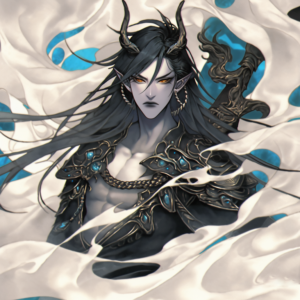Tsukuyomi is a significant deity in Japanese mythology, revered as the god of the moon. Born from the primordial deities Izanagi and Izanami, Tsukuyomi emerged as a celestial being responsible for illuminating the night sky. His origins and role in Japanese folklore contribute to his enduring presence in cultural traditions and beliefs.
Appearance
Tsukuyomi is often depicted as a graceful and ethereal deity, radiating the serene glow of the moon. He is portrayed with a serene expression and flowing robes that mirror the tranquil ambiance of the moonlit night. His gentle countenance and tranquil demeanor symbolize the tranquility and mystique associated with the moon.
Powers & Abilities
As the moon god, Tsukuyomi possesses powers and abilities linked to the moon’s influence. He has control over the cycles of the moon and the ebb and flow of its luminosity. Tsukuyomi’s abilities include casting moonlight to illuminate the darkness, bestowing blessings of tranquility, and overseeing the realm of dreams and emotions
Family
Tsukuyomi is the sibling of Amaterasu, the goddess of the sun, and Susanoo, the storm god. Their interactions and relationships within Japanese mythology shape numerous tales and legends. Tsukuyomi’s is the consort of his sibling Amaterasu highlights the balance and interplay between light and darkness, day and night, sun and moon.
The Death of Uke Mochi
Uke Mochi, the deity of nourishment, hosted a grand banquet. Regrettably, Amaterasu was unable to attend and instead delegated her consort, Tsukuyomi, to represent her presence. As Tsukuyomi observed Uke Mochi preparing the feast, he was profoundly repulsed by her peculiar methods. She expelled food from her mouth, and even produced food from other bodily orifices. Overwhelmed by disgust, Tsukuyomi impulsively ended her life then and there.
Upon receiving news of this dreadful incident, Amaterasu was filled with horror and condemned her husband as a malevolent kami, deeming him unworthy of returning to the celestial realm. This separation between Tsukuyomi and Amaterasu marked the origin of day and night. Throughout eternity, Tsukuyomi will endlessly pursue Amaterasu across the nocturnal sky, never able to reach her.
Symbol
Symbols associated with Tsukuyomi reflect his connection to the moon and its symbolism in Japanese culture. The crescent moon, in particular, is a prominent symbol often linked to Tsukuyomi, representing the waxing and waning phases of the lunar cycle. Other symbols may include tranquil night landscapes, silver hues, and images evoking the serenity and beauty of moonlit scenes.
Worship
Tsukuyomi is revered in Shintoism, the indigenous religion of Japan, and is honored for his association with the moon and its mystical qualities. Devotees offer prayers and perform rituals at specific moonlit shrines, seeking Tsukuyomi’s blessings for emotional balance, spiritual enlightenment, and guidance in matters of the heart. Rituals may involve offerings of sake, incense, and dances to evoke the ambiance of moonlit nights.
Facts about Tsukuyomi
- In some legends, Tsukuyomi is associated with the tides, with his presence believed to influence the rhythm and movement of the oceans.
- Tsukuyomi’s association with dreams connects him to the realm of subconsciousness and emotions, making him a deity sought after for guidance in matters of love, intuition, and introspection.
- Tsukuyomi’s tranquil and serene nature is often depicted in poetry, literature, and artwork, reflecting the Japanese appreciation for the beauty and tranquility of moonlit landscapes.






